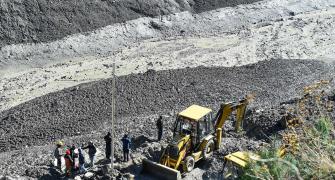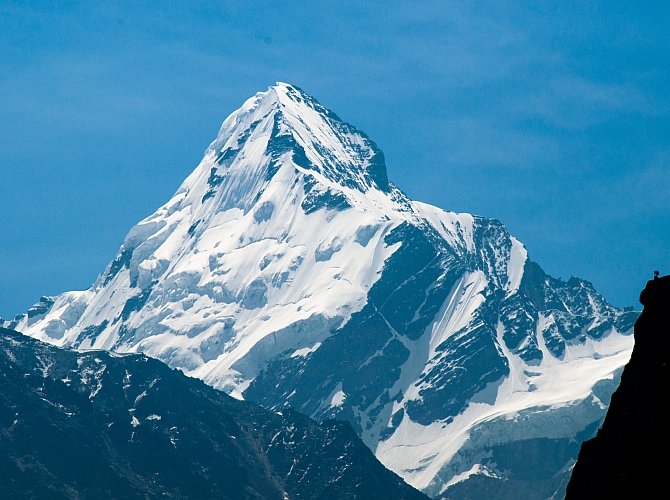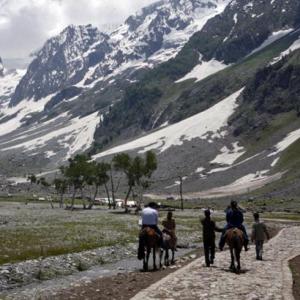'Half of China, India, Pakistan, Bangladesh Nepal, Bhutan, Myanmar, which are among the most populous countries in the world, are dependent on the rivers and glaciers of the Himalayas for sustenance.'

"As a geologist, my opinion is we should not carry out any construction activity in this fragile zone," Dr Pradeep Srivastava, a scientist at the Wadia Institute of Himalayan Geology based in Dehradun, tells Prasanna D Zore/Rediff.com in the final segment of an informative interview about the February 7 disaster in Chamoli, Uttarakhand, and its lessons for the region.
Would you say, as a scientist, that all the construction activity being carried out above a 2,000-2,500 metre elevation, in this most fragile 40-50 km stretch should not happen?
Yes, but there should be a different solution; we have seen clear evidence that these (big dams) are not sustainable there (in these region).
To build sustainable bridges, hydropower power projects and dams, we will have to spend more and so such solutions will come at a huge cost.
Having said this, as of now, as a geologist, my opinion is we should not carry out any construction activity in this fragile zone.
We do not have any visibly proven engineering solutions.
As a scientist I cannot say anything is not possible.
Most importantly, if the bridge has collapsed, if entire dams have been washed away then we need to sit with the construction design files, the detailed project reports (DPRs), and see where we went wrong.
DPRs provide detailed information about the geological feasibility, hydrological feasibility, design feasibility, etc., that will help us find out where we went wrong, learn our lessons and move on from there to build and design better solutions.

How fragile is the entire Himalayan ecosystem, not just in Uttarakhand, about across all the Himalayan states in India?
The fragility of the 40 to 50 kilometre zone is a comparative thing and fragility of any zone is a function of relief and elevation.
The moment you rise above the sea level there are forces that starts eroding you; as you move up and up in the Himalayas, the erosive forces become stronger and more active making that particular region more and more fragile.
In the lower Himalayas the relief features include thick forest cover, vegetation, dense human settlements and so the problems here are different from what they are at higher levels.
Fragility is a relative term; as you move lower and lower, fragility keeps decreasing.

Would you say that the lower Himalayas are safer places to have these constructions, but the middle and upper Himalayas may be no-go areas?
Yes. I believe we must have a wilderness zone in the Himalayas or wherever we carry construction activities and that was one of the recommendations to have several buffers (along the way) to the Char Dham roads, Chamoli and Kedarnath, Badrinath shrines.
Buffer zones would include controlled movement of people; like, if you have a good (tourist or people management) facilities at Rishikesh, and then at another town in Srinagar and then at another town in Chamoli, you can control movement of people in between (these four pilgrimage centres) facilitating controlled movement of pilgrims.
While we have towns at these places, they have sparse populations, and they do not have proper infrastructure to hold large batches of pilgrims and tourists at these places; infrastructure like clean toilets, planned construction of tourist lodges, availability of potable water, etc.
These facilities will come at a cost, but unless we have these in place just construction of roads will only help the locals to move out of their villages in search of better opportunities.
But if there are regular employment opportunities for the locals here through proper investments then not only a social problem will be solved but also help preserve these mountains that give us oxygen, a fertile landscape and abundant water bodies.
The Himalayas also protect India from our good neighbours; they also help in formation of the south west monsoon.
Not just India, but the Himalayas offer sustenance to one-fifth of the global population and if we don't protect these mountains then it has the potential to dent the global economy.
This is a very strong statement, but the Himalayas have the potential to dent the global economy because half of China, India, Pakistan, Bangladesh Nepal, Bhutan, Myanmar, which are among the most populous countries in the world, are dependent on the rivers and glaciers of the Himalayas for sustenance.
While not everything is translatable into dollars, we need to translate the dollar-denting capability of the Himalayas at least on the books so that we start taking its erosion seriously and embark upon finding environmentally sustainable solutions for its development.
Feature Presentation: Ashish Narsale/ Rediff.com











